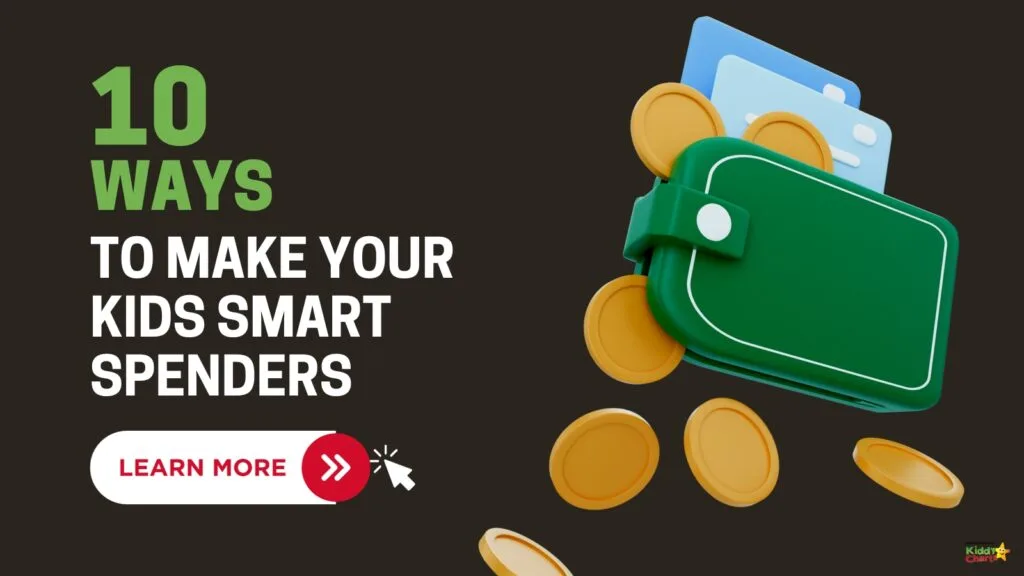According to the latest data, total household debt in America has increased to $17.06 trillion in the second quarter of this year. In the UK, household debt is c. $1.8Bn, so this isn’t just a US phenomenon. While there are likely to be various factors at play, poor financial literacy is probably not helping. That’s why we are looking at how you can teach your kids to be smart spenders.
Money management is a critical life skill everyone needs to learn from a young age. Teaching kids about money is not only beneficial for their immediate financial well-being but also sets the stage for a lifetime of smart financial decisions. In this article, we’ll explore ten essential strategies to empower your kids to become savvy spenders.
After all, financial literacy is more than just counting coins or swiping a credit card. It’s about instilling a sense of responsibility and making informed choices. As parents and caregivers, it’s our responsibility to guide them on this journey.
This is a collaborative post.

Luckily, there are many ways to equip children with the skills they need to become wise consumers, starting with the following ideas. Remember, it can be hard for those with neurodivergence to understand saving, and manage their money. This means it is important we are patient with them as we explain, and even model, sensible savings behaviour. In particular delaying gratification, and consequences are executive functions that those with ADHD have particular difficulties with.
The important thing is to be patient with our kids, and to realise that they will make mistakes on the way. This is part of learning, and with patience, and some support, there will be progress.
1. Set up an allowance system
Introducing an allowance system to your children is an invaluable lesson in financial responsibility. By providing them with a regular allowance, you create an opportunity for them to learn about managing cash, such as by allocating a portion of their money into categories like saving, spending, and sharing.
This division of funds instills the fundamental concept of responsible money management, teaching them to plan for the future, fulfill immediate needs, and give back to the community.

2. Teach them the value of money
Children need to understand that money is not a limitless resource. Offer opportunities to earn their allowance through age-appropriate chores or tasks. By doing so, they learn the importance of hard work, responsibility, and the fact that money doesn’t come easy.
This hands-on approach not only teaches them the value of their efforts but also fosters an appreciation for the money they earn, promoting a strong work ethic and a sense of financial self-worth.
3. Show them how to budget
At an early age, introducing your kids to the fundamentals of budgeting is a wise move to encourage them to be smart spenders. Show them how to set financial goals and create a basic budget. Whether through a physical ledger or kid-friendly budgeting apps, give them tools that help them manage their finances effectively.
Allow them to track their allowance and allocate money for specific purposes, whether toys, treats, or other goals. This early exposure to budgeting equips them with essential skills for managing their financial resources responsibly in the future.

4. Train them on delayed gratification builds smart spenders
Teaching children about delayed gratification is a vital lesson that can shape their financial habits. Explain that it’s perfectly acceptable to save for something they truly desire instead of mindlessly spending all their money.
This valuable lesson not only promotes patience and discipline but also helps prevent impulsive buying. Children learn to weigh their desires against their financial goals, encouraging them to make wiser spending choices and prioritize their long-term financial well-being.
5. Introduce comparative shopping
Teaching your children comparative shopping is a practical way to educate them on money matters. While shopping, engage them in comparing prices and finding the best deals. Help them understand that every product has a different price tag and that making informed choices is essential.
This lesson instills frugality and the art of responsible spending, empowering them to make wise financial decisions based on value and cost-effectiveness. Comparative shopping equips them with the skills to stretch their money further and make informed consumer choices throughout their lives.

6. Establish the difference between wants and needs
Empowering your children to distinguish between needs and wants is fundamental for their financial education. Sit down with them and explain that needs are essential items like food, clothing, and shelter, things vital for survival and well-being. On the other hand, wants can include items like toys, video games, and other non-essential luxuries.
Encourage your kids to prioritize their needs over wants when making spending decisions. This distinction can help them make conscious and responsible choices, ensuring their resources are allocated sensibly.
7. Open a savings account in their name
One of the most impactful ways to teach your children about saving is by opening a savings account in their name. Involve them in the process, taking them to the bank and showing them how to deposit their allowance or any gift money they receive.
Explain the concept of interest, demonstrating how their savings can grow over time. Many banks offer child-friendly savings accounts with features that make them more engaging, such as tracking tools or rewards for regular deposits.

8. Suggest exploring financial literacy resources
The world of financial literacy offers a treasure trove of resources designed to educate children. Books, websites, interactive apps, and, now, educational AI cater to various age groups and learning styles. Explore these resources together with your kids, using them as valuable tools to teach them about money management.
Some of these materials are not only educational but also entertaining, making the learning process enjoyable and engaging for your children. When they have fun with the lessons, they usually remember them better.
9. Encourage setting financial goals and reward good results
Motivate your kids to set financial goals that are achievable and meaningful to them is a great way to encourage smart spenders. Whether it’s saving for a new toy, a special outing, or any personal desire, setting goals instills a sense of purpose in their financial decisions.
Furthermore, attaching rewards to accomplishing these goals reinforces the significance of wise spending and saving. It motivates them to work toward their objectives and teaches the importance of discipline and patience in achieving financial success.

10. Teach them about charitable giving
Teaching children about charitable giving as a core aspect of financial literacy is a powerful way to instill values and social responsibility. By involving them in selecting a charity or cause, kids learn the importance of empathy and helping those in need. They grasp that money can be a force that drives positive change in the world.
This lesson not only expands their perspective on money but also fosters a sense of purpose and a broader understanding of the community and global issues. As a crucial component of their financial education, it helps them grow into socially conscious, well-rounded individuals.
Conclusion
Building smart spenders, and generating those smart spending habits in your children begins at home and continues throughout their lives. The ten strategies discussed in this article are essential building blocks to empower your kids to become financially responsible individuals.By imparting these valuable lessons, you pave the way for your children to make sound financial decisions and secure their future. However, remember that lecturing alone will not work. A Journal Family Relations study says modelling positive financial behaviours and providing experiential learning opportunities are still the most effective ways of moulding intelligent spenders.
We hope you like these ideas for kids and budgeting, why not check out some of the other money saving ideas we have on the site for parents and children:
Money saving printables on KiddyCharts
Here are some more ideas and printables for saving money on KiddyCharts - we hope that these help you out a little bit more with those money worries.
Mortgage deposit tracker: 5 signs you're ready to buy not rent the family home
Get that mortgage sorted with this deposit tracker - and easy way to save for that perfect house.
How to conserve energy at home: Includes 15-point checklist
Some ideas for conserve energy in the home, which of course, will save you money.
Money saving challenge printable: How to save 1000 in a month
Save yourself 1000 in a month with this easy to use and very cool printable idea.
5 tips for making eating out cheaper: Including budget envelopes
Eating out doesn't HAVE to be hard to do - here are some budgeting envelopes to help you save for those nights out and other ideas around the house.
Raise a saver not a spender with these FIVE money saving activities
More tips for raising a money saver, and not someone that spends whenever they can!
And here are some ideas from elsewhere too:
Budgeting ideas from outside KiddyCharts
Here are some more ideas for budgeting that we hope that you will find useful.
Frugal Tips To Save You Money When You Shop
Shopping can be tough when you need to save money - so here are some ideas to help you save while you are going around the shops from Miss Tilly and Me.
5 Fun & Educational Budgeting Games for Kids
Budgeting is a really important skill for kids to learn. So here are 5 games that your kids can play to help their budgeting skills.
How to create and maintain a family budget
Finally, it can be hard to know where to start when you are looking to create a family budget. So here you go - some more ideas for you to take a look at!
Do sign up to our newsletter for more awesomeness as well:
Thanks for dropping by,
Helen









